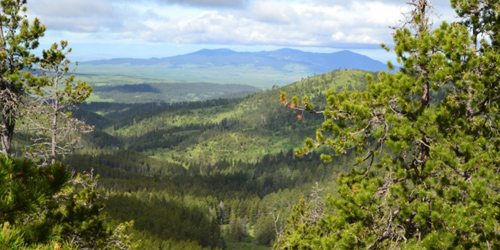Collar Peak Trail

Overview: Collar Peak Trail is a forested hike through the Judith Mountains leading to a view point from which, on a clear day, you can see for miles to the east across Central Montana.
Distance and difficulty: According to trail signs and hiking time, the trail is approximately 2.5 miles one way, or about 5 miles out and back. The trail starts at about 5,600 feet in elevation and rises to approximately 6,000 feet at Collar Peak. This trail is rated Beginning. The trail, for the most part, is easy to see and, while narrow in places, is stable under foot, being a mix of packed dirt and/or decomposing granite. There are short stretches of steep grades, especially near the overlook at Collar Peak. There is no water available on this hike; bring your own.
Directions: To reach the Collar Peak trailhead, take Highway 191 past the Fergus County fairgrounds - travel north for approximately 10 miles. Turn right on Maiden Road. (Watch for runners and cyclists on this road in the summer).
Travel 11 miles on Maiden Road; the first eight are paved and the rest is dirt road that in some seasons can be rutted, potholed or washboard-y. The trail head is on the right about half a mile past the turn off to Camp Maiden. Please note that some online sources put the distance to the trailhead at 13.5 miles, but it is only 11.
Trailhead: The trailhead is not developed and there is no developed parking. Park on the shoulder of an intersecting dirt road when you see the BLM sign for Collar Peak Trail. There are no facilities at this trailhead.
Description: The trail is narrow but easy to see as it heads out through the densely timbered slopes just southeast of Judith Peak. It winds along the hillside through the woods, either flat or slightly downhill, for the first three-quarters of a mile or so. Breaks in the trees allow the occasional glimpse of the surrounding peaks, and also tailings from old mining activity in the area.
At about the half mile mark, the trail crosses Collar Gulch Creek, which is dry in the summer but may have snow-melt runoff in the spring. Shortly after crossing the creek-bed, the trail makes a turn to the south and begins to climb some. Hikers will travel across the ridge top leading to Collar Peak. The trail becomes rockier here, so watch your footing in the gravel. When crossing exposed bedrock, the trail is less easy to see but is still fairly visible.
The final stretch of the hike, about the last half a mile or so, is quite steep and rocky with a few trees down. One or two of the downed trees have fallen across the trail, but hikers have created short, easily navigated detours around these. Take your time climbing the steepest sections and watch your footing.
The trail approaches the top of Collar Peak through the trees, keeping the hiker in suspense until finally breaking out into grassy meadows with large rock outcrops, the perfect place to rest and enjoy stunning views to the east. On clear days you can easily see for 50 to 60 miles across Central Montana. Count the number of lakes you can see, or the number of types of wildflowers blooming at your feet if you are there in the summer.
Note: if the weather is cloudy, this exposed hilltop is not a good place to linger, especially if there is thunderstorm activity in the area. In the spring, fall and summer months you will likely see tree squirrels, chipmunks, and the occasional deer on this hike. Look for mountain-dwelling songbirds, such as chickadees and juncos, in the forested sections, and raptors (hawks and eagles) or crows taking advantage of the thermals off the top of Collar Peak.
This is an out-and-back hike, so simply reverse direction to return to the trailhead. In reverse, the trail is steeply downhill and somewhat “skiddy” (go slowly and watch your footing) as you descend from Collar Peak to the ridgetop, slightly downhill to Collar Gulch Creek, then relatively level or slightly uphill to the trailhead.
Please note that while every effort has been made to guarantee accuracy in trail descriptions, errors in recording mileage and trail conditions can occur. Also changes occur on the land; some descriptions that were accurate when written may be inaccurate later. One storm, for example can block a road or trail. The responsibility for good health and safety while hiking is that of the user.
Ratings: Hikes are rated as beginner, intermediate and advanced. Beginning hikes are those which are mostly flat or with only short stretches of steep grades, and with well-marked, easy to follow trails. Intermediate hikes are those with very steep or very long grades, or with trail surfaces which are somewhat unstable.
Advanced trails are those with very steep, or very unstable trails, those that require some climbing or those which are not well-marked or which contain stretches of off-trail hiking. None of these hikes requires technical climbing. Hikers should adjust these ratings for their own fitness and experience levels.


Collar Peak Trail